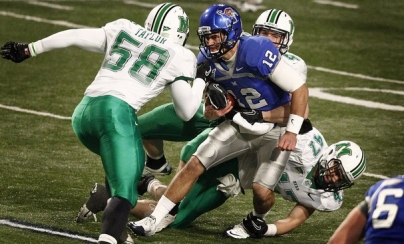By Mike Kuchar
Senior Research Manager
X&O Labs
Editor’s Note: We should be clear that this report focuses solely on a pressure check system, meeting blitzes that are NOT called from the sideline, but instead are CHECKED from the sideline based on various offensive variables such as offensive formation, down and distance, offensive personnel and field position.
Case1: Introduction and Protocols:
 Plain and simple, this special report is centered on pressure- where to bring it, how to bring it and when to bring it. When creatively designed and accurately called, a pressure system cannot only be detrimental to offenses it can be downright degrading. While offensive coaches spend hours watching game film on how to attack defenses, defenses are finding new ways to counter what offenses present and they are doing so by pressuring tendencies on a down to down occurrence. What if you were able to put your players in the best possible situation to be successful each and every play? You’d be foolish not to. A pressure check system allows you that opportunity.
Plain and simple, this special report is centered on pressure- where to bring it, how to bring it and when to bring it. When creatively designed and accurately called, a pressure system cannot only be detrimental to offenses it can be downright degrading. While offensive coaches spend hours watching game film on how to attack defenses, defenses are finding new ways to counter what offenses present and they are doing so by pressuring tendencies on a down to down occurrence. What if you were able to put your players in the best possible situation to be successful each and every play? You’d be foolish not to. A pressure check system allows you that opportunity.
Why Use a Pressure Check System
There are plenty of reasons as to why coaches use a pressure checks system, all of which will be explained thoroughly in this report. The fact is 49.7 percent of coaches have been using a pressure check system for over five seasons now. Of these coaches, 28.1 percent will teach a check on roughly 50-74% of every called pressure down. What this means is that coaches will want pressure and communicate they will pressure, but where they pressure depends on various variables. We were inundated with responses from coaches at all levels preaching the advantages of using a pressure check system. The most common benefits are below:
- It complements no-huddle offensive systems- With offenses rushing to get on the ball and get it snapped, checking pressure eliminates any further verbiage from the sideline. In fact, coaches like Brown University’s defensive coordinator Mike Kelleher will use one word to denote the front, coverage and pressure. “We have about 10 calls where we will use against these up-tempo teams,” Kelleher told us.
- Takes advantage of offensive tendencies- This response was particularly common among high school coaches where tendencies are a little more prevalent. Once your game plan is in, create your pressures based off offensive formations.
- Eliminates bad play call capabilities- Why stay in a poor blitz call if you don’t have to? Using a pressure check system based on offensive tendency always gives your defensive the opportunity to check out of a poor call.
- Combats offensive pre-snap movement- Once offenses get on the ball they can get in a situation where pre-snap movement can pull you out of a pressure. Instead of running the pressure- or checking out of it- you can adjust the pressure to attack its vulnerability.
- Attacks Protections- We have found coaches will design their pressure check system against various protection variables such as back placement, Center movement, offensive line oversets and weak spots. Pressures can be tagged to attack each of those situations.
- “Opposite” Calls- What this means is that if a pressure gets detected and an offense can adjust, having a pressure check system allows you call the pressure opposite the detection, thus still getting home. Now, this part of it takes a tremendous deal of coaching, but still an advantage.
- Harnesses Unpredictability- Blitz checks can be made instantaneously at the line of scrimmage which makes it nearly impossible for offenses to determine where the blitz is coming from.
- Can be a Game Changer- If checked at the right time against the right tendency, a pressure can not only disrupt the play but also impact the entire course of the game.
- Defends Read option teams- Depending on the placement of the back, pressure checks can be designed to attack certain zone reads and power read scenarios.
- Fun for your players- Once you set up your pressure check system, it gives players accountability when making the checks. They have fun doing it.
- Helps smaller players play fast- Blitzing has always been a great equalizer on defense. It is even a better option for teams that lack the beef up in the box.
- Develops football IQ- This was one of the more intelligent responses we received from coaches. In order to develop a pressure check system, you need to teach your players how to identify formations, protections and personnel groupings just to get the right pressure. Again, it makes them accountable for their decisions, which means they have to be continual learners.








